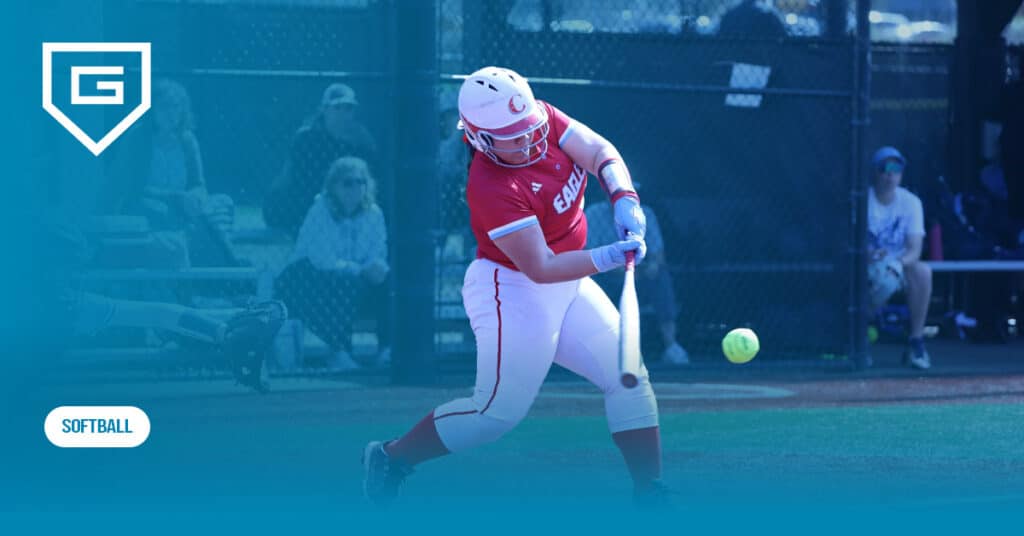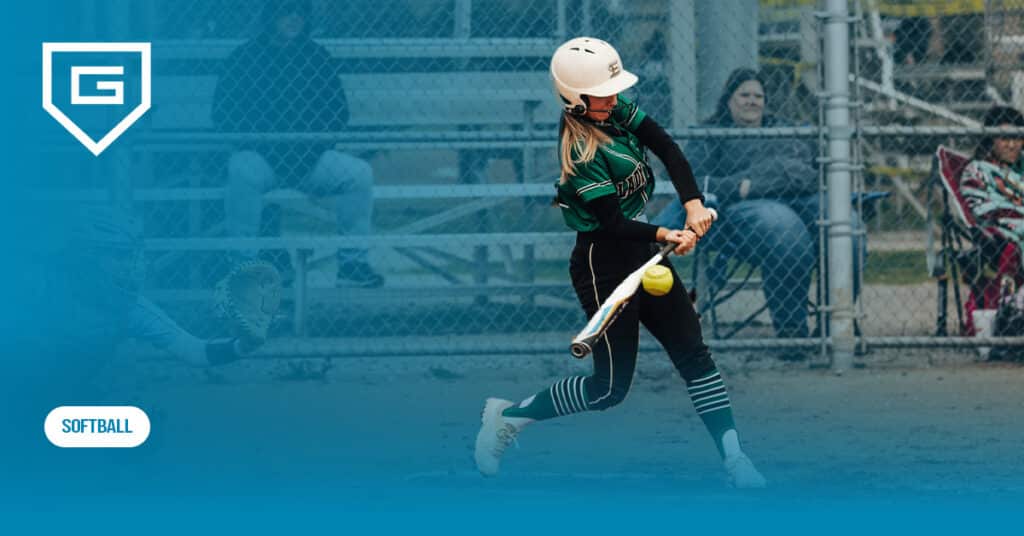Football Defensive Schemes: 11 Essential Fronts and Coverages
Reading Time: 12 minutes
Reading Time: 12 minutes
Are you trying to improve your defensive game?
In this blog post, we will explore different football defensive schemes, and the fronts and coverages that fall within them. Its purpose is to help you create an unstoppable defense on the field!
Whether you’re a coach looking to shake up your team’s strategy or a player looking to expand your knowledge of defensive tactics, these schemes will provide you with the insight and strategies you need to dominate on the defensive side of the ball.
Let’s get started.
What are Football Defensive Schemes?
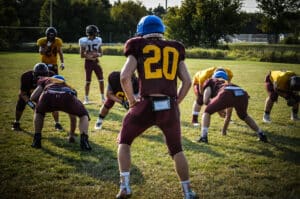
Football defensive schemes are the alignments a defense uses to counter offensive plays. Different fronts are named according to the number of defensive linemen and linebackers involved in the formation, and coverages more specifically describe the roles of defensive backs in a play.
Defensive formations are highly variable. They typically position four or five defensive linemen, linebackers, and defensive backs and dictate their responsibilities against both run and pass plays.
Coverage schemes, such as man-to-man coverage and zone alignments, determine how defenders cover receivers on the opposing team and protect against passing plays. Man-to-man creates 1-on-1 matchups across the field, whereas zone alignments define areas of responsibility for individual defenders.
Blitzes create pressure on the opposing team’s quarterback. Run defense strategies focus on gap control, containment, and shedding blockers to stop the run.
Mixing defensive formations and creating a hybrid scheme creates confusion for the opposing team’s offense and exploits their weaknesses.
Why are Football Defensive Schemes Important?
Football defensive schemes neutralize the opposing team’s strengths, whether a solid running game, a high-powered passing attack, or a balanced offense.
These schemes align players in defensive formations and assign them specific responsibilities to maximize their talents and skills. They also create confusion and unpredictability for the opposing offense using strategies like blitzes or zone coverages to disrupt offensive timing, leading to more mistakes and turnovers.
The unpredictability of these schemes makes it challenging for quarterbacks to read the defense and for offensive linemen to block.
Defensive formations are versatile and can be adapted to different game situations, such as down and distance, field position, and score. These formations are crucial in critical moments like third downs and red-zone situations.
11 Football Defensive Schemes to Boost Team Results

Football defensive schemes counteract offensive strategies and maximize the strengths of defensive players. By deploying the right defensive fronts and coverages, a team can improve its performance by making more regular stops, causing turnovers, and achieving better results.
Here are 11 key defensive fronts and coverages to implement in your scheme that will boost your team’s performance!
-
The 4-3 Defense
Many teams deploy this front as their base defense to highlight strong defensive line play and versatile linebackers. The Buffalo Bills’ 4-3 defense takes advantage of their defensive line depth and the athleticism of their linebackers.
Overview
The 4-3 defense is a common base defense for football teams at all levels. This scheme features four defensive linemen, three linebackers and four defensive backs. It focuses on speed and athleticism to effectively counter the run and a passing attach.
Key components
- Defensive linemen: Two defensive ends are responsible for setting the edge against the run and pressuring the quarterback. The two interior defensive lineman’s role is to clog running lanes and push the pocket from the inside.
- Linebackers: The 4-3 defense includes three linebackers. The strong-side linebacker covers the tight end and supports the run. The middle linebacker reads the play and often calls for defensive adjustments. The weak-side linebacker covers the weak side to help in coverage and defend runners at the second level.
- Defensive backs: Two cornerbacks and two safeties provide pass coverage and support run defense.
Advantages
- Balance and flexibility
- Simplified gap control
- Consistent pass rush
Implementation tips
Prioritize speed and athleticism with fast, agile defensive ends and linebackers who can react quickly to plays and close down running lanes. Gap control, tackling, and proper alignment maintain the integrity of the 4-3 defense. Blitzes keep the offense guessing and create more opportunities for big plays.
2. The 3-4 Defense
The Baltimore Ravens, Pittsburgh Steelers and Green Bay Packers use 3-4 Defense for flexibility and unpredictability.
Overview
The 3-4 defense features three defensive linemen and four linebackers. It allows teams to adapt quickly to run and pass plays. It prioritizes using four athletic linebackers who can rush the passer as well as drop into coverage. This football defensive scheme is a favorite for creating confusion and disguising pressure.
Key components
- Defensive line: A nose guard lines up directly over the center, and two defensive ends line up over the offensive tackles. The nose guard clogs the middle while the defensive ends control the edges and engage blockers.
- Linebackers: There are four linebackers—two inside and two outside. The inside linebackers concentrate primarily on run defense and intermediate pass coverage. The outside linebackers are more commonly pass rushers, but are athletic enough to drop back into coverage.
- Defensive backs: Two cornerbacks and two safeties have dual roles in run support and pass coverage.
Advantages
- Versatility
- Improved athleticism up front
- Effective run defense
Implementation tips
The nose tackle must take on double teams and maintain their position to free up linebackers. Agile linebackers must have speed and be skilled in both pass rush and coverage. The 3-4 scheme relies on players understanding their roles and responsibilities, so an effective coach-to-player communication system is vital.
3. The Nickel Defense
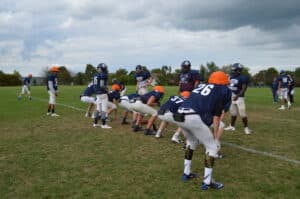
The Kansas City Chiefs, Arizona Cardinals and Houston Texans frequently call for the Nickel Defense to counter pass-heavy offenses. The Nickel also allows for exotic blitz packages, spies, and many variations of zone coverage.
Overview
The Nickel Defense, also known as the 4-2-5 defense, is a strategic formation that uses five defensive backs instead of the traditional four. This formation counters offenses with many passing plays, especially those with three or more wide receivers. The term ‘nickel’ refers to a fifth defensive back, the Nickelback, who replaces a linebacker or defensive lineman, adding a unique element to the game.
Key components
- Defensive backs: The trademark of the Nickel Defense is the five defensive backs—two cornerbacks, two safeties and the nickelback.
- Down linemen: The formation includes four defensive linemen to pressure the quarterback.
- Linebackers: With the substitution of the extra defensive back, only two linebackers remain on the field.
Advantages
- Improved pass coverage
- Improved matchups
- Flexibility in blitzes
Implementation tips
When using this defensive scheme, defensive backs must practice football drills that highlight speed and coverage skills. The Nickelback covers slot receivers and supports the run and can help in blitzes. Communication and coordination are crucial for the defense to adjust to offensive formations and shifts.
4. The Dime Defense
The Denver Broncos famously used the Dime Defense during Super Bowl 50 to neutralize passing attacks in third-and-long situations.
Overview
The dime defense is a defensive formation used in obvious passing situations. It involves six defensive backs instead of four or five for better pass defense coverage against medium to long-range passing plays. This defensive formation is effective when the opposing team’s running game is weak or is facing time constraints.
Key components
- Six defensive backs: This includes two safeties and four cornerbacks.
- Defensive front: Four linemen with one linebacker or three with two linebackers are involved.
- Flexibility: The sixth defensive back, the “dimeback,” adds extra coverage to wide receivers.
Advantages
- Reduced opponent pass completion
- Flexibility against spread offenses
- More interceptions
Implementation tips
Defensive backs need to cover a lot of ground quickly. Football coaches should teach players their coverage responsibilities and communicate effectively to avoid coverage breakdowns. A defensive coordinator trains their defense to recognize and adapt to different offenses, making the switch to dime coverage responsibilities easy.
5. The 46 Defense
Most teams regard the 1985 Chicago Bears as one of the greatest defenses in NFL history. Buddy Ryan’s 46 Defense terrorized offenses throughout the season, leading to their Super Bowl XX win against the New England Patriots.
Overview
The 46 Defense is a unique and aggressive scheme that applies constant pressure on the opposing offense. Its distinct alignment, with six players on the line of scrimmage, is designed to disrupt both running and passing plays by overpowering the offensive line through mismatches.
Key components
- Defensive line: Four down linemen aim to penetrate and disrupt the offense. The defensive ends line up outside the offensive tackles, and a defensive tackle is positioned to attack the gaps.
- Linebackers: Two linebackers are positioned five yards off the line of scrimmage for run support and pass coverage.
- Secondary: There are three defensive backs, two cornerbacks in man-to-man coverage and a single deep safety. The strong safety on the line of scrimmage adds to the pressure.
Advantages
- Stacked line of scrimmage
- It creates pressure on the quarterback
- Adaptable for run and pass defense
Implementation tips
The strong safety and strong-side linebacker must have great football conditioning to engage physically at the line of scrimmage. The free safety needs to be quick and able to read the field. In this aggressive football defensive scheme, stunts and blitz packages keep the offense off balance and maximize pressure with a strong front.
6. The Cover 1 Defense
The Houston Texans and Indianapolis Colts use the Cover 1 Defense to strengthen their pass defense and apply man-to-man coverage.
Overview
Cover 1 Defense is a man-to-man coverage scheme with a single high safety providing deep coverage over the top. The remaining defensive backs cover offensive players man-to-man. One linebacker or defensive back, the “robber” or “hole” player, patrols the short middle zone.
Key components
- High safety: This player stays deep in the middle of the field for deep coverage. His goal is to either pick up a blown coverage assignment by a corner, or move to double cover the intended receiver.
- Man-to-man coverage: All other defensive backs cover their assigned receivers man-to-man.
- Robber/Hole defensive player: A linebacker or defensive back covers the short middle zone while reading the quarterback and jumping short routes.
Advantages
- Strong against the pass
- Simplified assignments
- Effective against short passes
Implementation tips
Defensive backs must master one-on-one coverage to execute the Cover 1 Defense. The defensive coordinator, a pivotal figure, fosters robust communication among defenders for swift defensive reactions. The single high safety, a key player, must be agile and sharp, capable of deciphering the quarterback’s intentions and covering a substantial area.
7. The Cover 2 Defense
The Tampa Bay Buccaneers used Cover 2 Defense to win games in the late 1990s and early 2000s.
Overview
The Cover 2 defense is one of the most commonly seen zone-based coverage plays with two deep safeties. It splits the coverage between the two deep safeties to cover deep passing threats. Five defenders are also in the intermediate zones for short passes.
Key components
- Two deep safeties: They cover deep halves of the field.
- Cornerbacks: These players play the flats and jam receivers at the line of scrimmage to disrupt routes and timing.
- Linebackers: Drop into intermediate zones to cover crossing routes and short passes.
Advantages
- Balanced coverage
- Run support
- Disrupts timing routes
Implementation tips
Safeties must cover significant ground and read the quarterback’s eyes well. Cornerbacks need to be physical to jam receivers at the line of scrimmage and cover the flats. Linebackers should drop into coverage and provide run support. Use a football practice plan built on rerouting receivers and maintaining proper zone responsibilities.
8. The Cover 3 Defense
The Seattle Seahawks’ “Legion of Boom” defense used Cover 3 during their successful seasons in the 2010s.
Overview
This zone coverage scheme protects against the run and the pass by dividing the field into thirds. Three deep defenders are each responsible for one-third of the deep field. Four defenders are responsible for covering the short to intermediate area.
Key components
- Deep thirds coverage: Three defenders split the deep part of the field into thirds.
- Underneath zones: Four defenders cover the underneath zones.
- Single high safety: A free safety in the middle of the field has deep coverage responsibilities.
Advantages
- Balanced defense
- Run support
- Deep ball protection
Implementation tips
Focus on teaching discipline so players maintain their assignments and are not lured out of position by play-action fakes or misdirection. Practice pattern-matching techniques to adapt to changing offensive coordinators.
9. The Tampa 2 Defense
The Tampa 2 Defense, along with defensive coordinator Monte Kiffin, played a crucial role in the Buccaneers’ Super Bowl XXXVII victory.
Overview
The defense is a variation of Cover 2, with two safeties covering deep zones and a middle linebacker in the midfield. The cornerbacks and outside linebackers cover the shorter, flat zones.
Key components
- Defensive lineman: Two defensive tackles and two defensive ends – one tackle focuses on plugging the A-gap, and the other is a pass rusher.
- Linebackers: The middle linebacker drops into the deep middle. The outside linebackers cover the flat zones and support against the run.
- Secondary: Two safeties provide deep coverage. The cornerbacks handle the outer flat zones and disrupt receivers.
Advantages
- Effective against the pass
- Run support
- More turnovers and interceptions
Implementation tips
Focus on tackling and zone coverage responsibilities with defensive tackles. The defensive team must have effective communication to cover zones and adjust to offensive plays.
10. The Zone Blitz Defense

The Pittsburgh Steelers defensive coordinator Dick LeBeau used the zone blitz defense during their victory in Super Bowl XLIII.
Overview
The zone blitz is exactly as it sounds: blitz pressure under the guise and support of zone coverage. It’s a defensive scheme that confuses the offense by disguising which players will rush the quarterback and which will drop into coverage.
Key components
- Multiple blitzes: Five or more players rush the quarterback.
Zone coverage: The remaining defenders cover zones 3-deep and 3 underneath. - Pre-snap disguise: The defense looks before the snap and changes immediately to confuse the opposing offense.
Advantages
- Confuses offenses
- Creates pressure with coverage
- Effective against screens
Implementation tips
Defenders need to disguise the play. Add blitz and coverage combinations to your football practice script to keep offenses guessing. You will need a variety of personnel across the field to be comfortable dropping back into coverage.
11. The Cover 4 Defense (Quarters Coverage)
With the Seattle Seahawks, Pete Carroll uses variations of the Cover 4 defense against deep passing threats.
Overview
The Cover 4 defense, or quarters coverage, involves four defensive backs, each responsible for a deep quarter of the field. This scheme emphasizes deep pass coverage while providing support against the run.
Key components
- Defensive front: A 4-3 or 3-4 front focuses on creating pressure and either defending against the run or covering the short and intermediate area.
- Secondary: Four defensive backs split the deep coverage into quarters.
Advantages
- Strong deep coverage
- Effective run support
- Versatile
Implementation tips
To avoid coverage lapses, focus on strong communication among defensive backs. Emphasize reading the quarterback’s eyes and quickly reacting to the football and ball carrier.
How GoRout Boosts Football Defensive Schemes
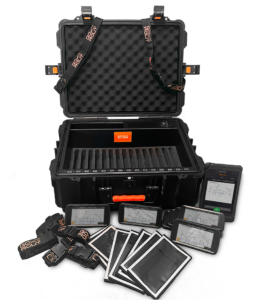
The GoRout football play-calling system streamlines communication between coaches and players, saving time and optimizing practice efficiency.
As the preferred choice for thousands of football coaches nationwide, GoRout has transformed practice routines and boosted weekly preparation.
Read coaches’ testimonials to learn more about their results.
This sports coaching technology helps teams stay one step ahead of the competition by making it easier to train for game day.
With GoRout equipment, coaches and players can instantly share and access play calls, increase practice reps, and improve performance during practice and games.
Practice scripting

GoRout practice scripting software saves time and improves preparation for practices and games. It seamlessly integrates with popular play drawing tools to simplify practice scripting and organization.
This app offers features for adding, editing, copying, and reordering football practice scripts or football coaches’ play cards.
On-field coaches practice app
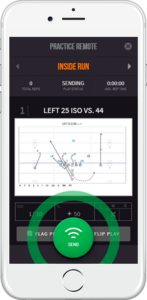
The on-field football practice app uses GoRout STEEL™ to streamline practice sessions by managing the start and end of practice, organizing scripts and sharing football screen plays via a custom on-field remote.
It improves communication with each player through on-field formation flipping, one-tap play flagging for instant review and live-editing of cards directly on the field.
Player device
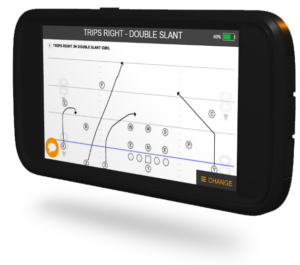
The GoRout player device is the toughest wearable technology in sports designed to withstand the demands of long and rigorous football practices and games.
This football practice device eliminates the need for setup or WiFi connectivity for a hassle-free experience straight out of the box. Coaches distribute play calls to players by selecting specific practice groups and have access to play drawings and position-specific messaging.
Get a quote today to see how we can help your team win on the football field this season.
Key Reasons to Prepare Your Team for Game Day with GoRout
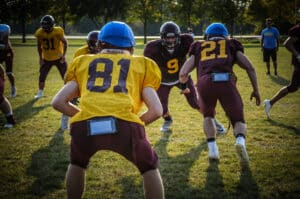
Advanced football wristbands can optimize your team’s practices and prepare players for game day.
Here are the key benefits of using the GoRout football practice system:
- Expert development: The system was created by experienced coaches, providing an advanced solution based on firsthand coaching experience.
- Seamless integration: Effortlessly integrate with play drawing tools and hand-drawn cards to improve practice sessions.
- Increased efficiency: GoRout increases average reps by 3x, providing more coaching time and opportunities for player improvement.
- All-weather performance: The system thrives in diverse weather conditions, including extreme temperatures, humidity, and precipitation.
- Full-coverage warranty: Users benefit from a 100% warranty, offering confidence in the system’s reliability, security, and durability.
- Positive testimonials: GoRout got endorsements from fellow coaches who have used the system to enhance communication and player development on the field.
Get a quote now and improve player development and communication on the field.
Conclusion on Football Defensive Schemes
Football defensive schemes play a critical role in a team’s success. A well-designed defensive strategy can effectively shut down the opponent’s offense and create opportunities for turnovers.
When choosing a defensive scheme, coaches and defensive coordinators must consider various factors, such as their players’ strengths and weaknesses, the opposing team’s offensive tendencies, and game situations.
With advanced football coaching technology like GoRout, teams can perfect their scheme in practice and communicate clearly for a winning season. For additional results, check out our youth football playbook.
Ready to boost your game? Get a quote today and see the difference for yourself!





